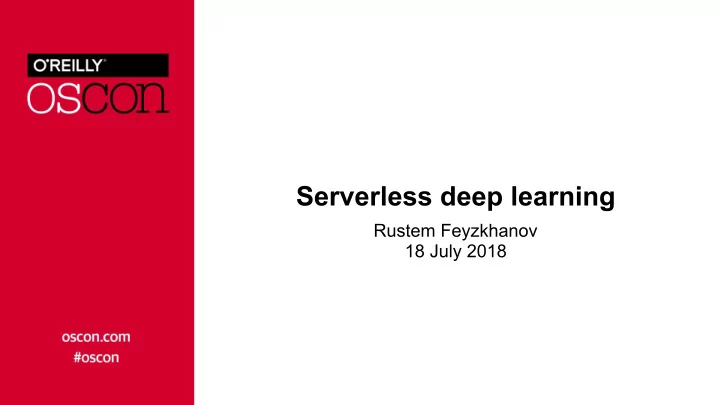

Serverless deep learning Rustem Feyzkhanov 18 July 2018
Data science process Business Data Customer Modeling Deployment understanding acquisition acceptance - Define objectives - Ingest data - Feature selection - Operationalize - Testing and - Identify data - Explore data - Create model validation sources - Update data - Train model - Handoff - Re-train and re- score from https://docs.microsoft.com/en-us/azure/machine-learning/team-data-science-process/overview
Data science process Challenges: Deployment - starting fast - being flexible - integrating in current Customer Modeling acceptance infrastructure from https://docs.microsoft.com/en-us/azure/machine-learning/team-data-science-process/overview
Takeaways from this talk • How serverless deep learning works • Serverless deep learning architecture • Serverless deep learning use cases, do’s and don’ts • Serverless deep learning simplicity of code
Function as a service (FaaS) On premise FaaS SaaS IaaS PaaS Functions Functions Functions Functions Functions Application Application Application Application Application Runtime Runtime Runtime Runtime Runtime Operating system Operating system Operating system Operating system Operating system Virtualization Virtualization Virtualization Virtualization Virtualization Networking Networking Networking Networking Networking Storage Storage Storage Storage Storage Hardware Hardware Hardware Hardware Hardware
Lambda function - AWS implementation of FaaS
How Lambda works ‣ S3 ‣ API Trigger ‣ DynamoDB ‣ SQS, Kinesis Response Container pool Warm container ‣ Code ‣ Libraries ‣ Configuration (memory, max time) Lambda configuration
Lambda triggers S3 CloudWatch DynamoDB API gateway Lex SQS
Lambda pros/cons/limits Pros Cons Limits max 3 GB RAM Easy to deploy (no docker) Logging is not great max 500 MB disk Easy to connect to triggers No local debug (API, S3, SQS, DynamoDB) max 5 min execution time Unpredictable warm Easy to scale containers CPU is proportional to provisioned memory Relatively cheap
TensorFlow popularity Google web search interest for di ff erent deep learning frameworks over time Francois Chollet. “Deep Learning with Python MEAP .”
TensorFlow 1.* • Keras in the core • TF Boosted trees (!) + other ML algorithms • Lots of other stu ff : https://github.com/tensorflow/tensorflow/blob/master/RELEASE.md
Why TF on Lambda? ~20000 runs for $1 1000 concurrent executions (up to 10000) Pay as you go model => perfect for early stage projects
Implementation Problem Lambda limit - 50 MB TensorFlow archive size - 43.1MB Numpy archive size - 16.5 MB + dependencies
Implementation Problem Lambda limit - 50 MB TensorFlow archive size - 43.1MB Numpy archive size - 16.5 MB + dependencies 250 MB unarchived https://hackernoon.com/exploring-the-aws-lambda-deployment-limits-9a8384b0bec3
How to solve + + + Docker Amazon Linux PyPI wheels Magic 1.Compress so files Magic: 2.Delete .pyc files 3.Remove test folders, visualisation folders Look up here: https://github.com/ryfeus/lambda-packs/blob/master/Tensorflow/buildPack.sh
How to import models Use Keras or TensorFlow for h5 files pb files weights import: • Keras - h5 files • TensorFlow - pb files
Usual AWS architecture for DL ECR EC2 Route 53 ACG Spot ALB ECS
Architecture for DL using Lambdas S3 Route 53 API Gateway Lambda
Architecture for DL using Lambdas S3 SQS Lambda
Architecture for DL using Lambdas S3 SQS Lambda Step function
Architecture for DL using Lambdas Step functions: - allow modular approach - enable to handle errors and special cases - serverless functions => serverless pipelines
Where to get models Train yourself Keras: https://github.com/fchollet/deep-learning-models TensorFlow: TensorFlow ZOO (https://github.com/tensorflow/models/tree/master/o ffi cial) TensorFlow.org (https://www.tensorflow.org/performance/performance_models) Github projects (e.g. https://github.com/taehoonlee/tensornets)
Projects - Image recognition API to recognize image using Inception-v3 - 0.00005$ / 1 image https://github.com/ryfeus/lambda-packs/tree/master/Tensorflow https://www.tensorflow.org/tutorials/image_recognition
Projects - accessible WEB API to describe what happens on the picture - 0.0001$ / 1 image Abhinav Suri - https://medium.freecodecamp.org/making-the-web-more-accessible-with-ai-84598eebabdb
How do you know if this is for you - You want to deploy your model for pet project - You want to make s simple MVP for your startup/project - You have simple model and this architecture will reduce cost - You have peak loads and it is hard to manage clusters
How do you know if this is NOT for you - You have very complex model (a lot of data as input/high CPU) - You need to have real-time response
Some new stuff - LightGBM package - fast, distributed, high performance gradient boosting framework from Microsoft + Sklearn/Scipy/Numpy https://github.com/ryfeus/lambda-packs/tree/master/ LightGBM_sklearn_scipy_numpy - Spacy package - natural language processing library https://github.com/ryfeus/lambda-packs/tree/master/Spacy
Conclusions + = Presentation: http://bit.ly/2L72P2y Checkout here: https://github.com/ryfeus/lambda-packs (https://goo.gl/HQiHD7)
Recommend
More recommend